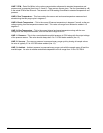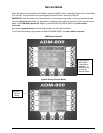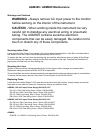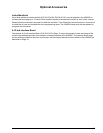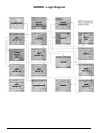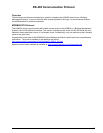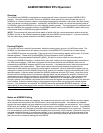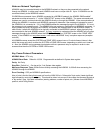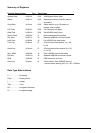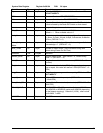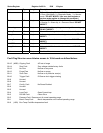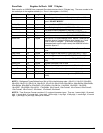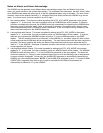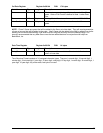
68 Instruction 3015-4275
AGM300 MODBUS RTU Operation
Overview
The AGM300 and ADM800 are equipped to communicate with other equipment using the MODBUS RTU
protocol. Using this communication channel a MODBUS master device may communicate with up to 15
AGM300s on a communications network, exchanging measurement information, alarm data, fault data, history
(logs and trends) and setup information. Additionally, the MODBUS master can control the operating state of
an AGM300, placing the AGM300 in any of its different operating modes. The network may be configured such
that the AGM300s are connected directly to the MODBUS master device, or the MODBUS master device may
communicate with the AGM300s through the ADM800.
(NOTE: This document will assume that the reader is familiar with the various parameters used to set up the
AGM300, as well as the different operational modes that the AGM300 may be placed in. If you are unfamiliar
with this information, please reference the AGM300 operations manual.)
Protocol Details
A 2 wire RS-485 bus is used for transmission, therefore communication occurs in a Half-Duplex mode. The
AGM300 is a slave device and will respond to queries in the MODBUS RTU format from a master device.
Two MODBUS functions are supported. They are function 03 (read holding register) and function 16 (Preset
Multiple registers). Please refer to the MODBUS Protocol Reference Guide (available at
www.modicon.com/techpubs/techPubNew/PI_MBUS_300.pdf) for protocol detail and use instructions.
Using the two MODBUS functions, a master device may read, modify and write data and status information to
any AGM on the network. AGM data is organized into structures (internal to the AGM300) which can be
accessed by the MODBUS registers defined in this document. A corresponding set of data structures should
be maintained by the master device. These master device data structures become the destination for
responses to read queries and sources for preset register commands. When a read holding register query is
made by the master device the AGM300 responds by sending the contents of the structure referenced by the
specified register. After the master validates the AGM300 response using the CRC bytes, it must then move
the data into its matching data structure before individual items may be accessed or modified. Therefore, the
master data structure should correspond to the AGM300 data structure byte for byte. Note that some data
structures have been divided into multiple registers due to MODBUS RTU message length constrains. To
change a setting in the AGM300, the master device first reads the register structure that contains the data item
to be modified, makes the desired change, then sends the structure back using the preset multiple register
function. If the transaction is successful, the AGM300 sends the appropriate MODBUS response. It is the
responsibility of the master device when making modifications to insure that all parameters trasfered fall inside
the working limits of the AGM300.
Notes on AGM300 Polling
After the AGM300s are setup and operating, the master device need only poll each AGM for its status register
which contains summary data of the AGM’s alarms, faults, and operating state. If exceptions are detected
through the status register and more details are required, additional registers can be examined. Also if current
PPM values are required, the PPM register provides access to current PPM values for all zones. The AGM300
requires a minimum of 20 seconds to complete a gas concentration measurement for a single zone. Therefore,
it is not necessary to poll the AGM300 more frequently than once every 15-20 seconds, as there will not be any
new data available/obtained by more frequent polling. In fact, excessive polling will slow the operation of the
AGM300. Under no circumstances should the AGM300 be continuously polled at rate faster than 500mS, as
this could result in erroneous readings by the AGM300.



